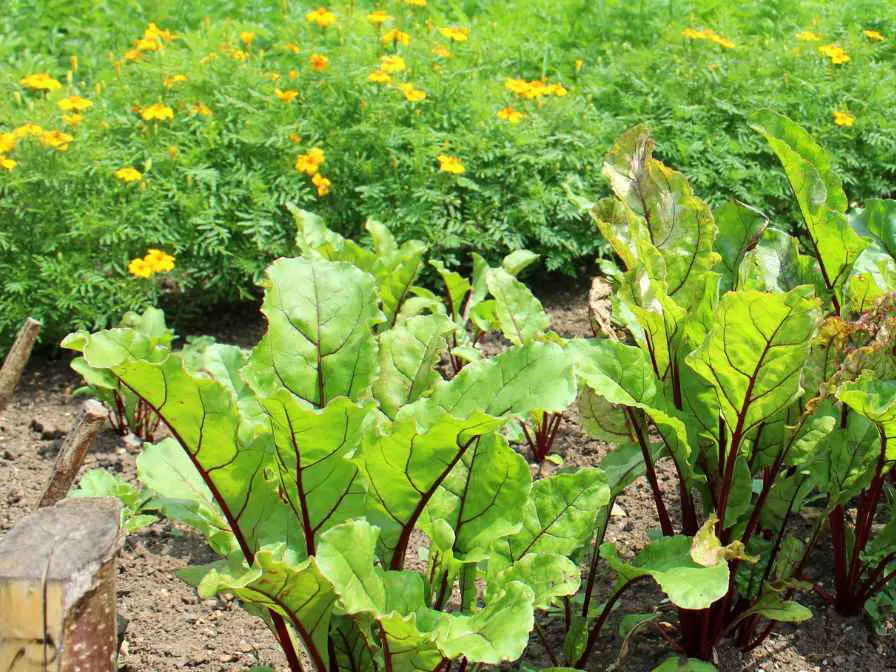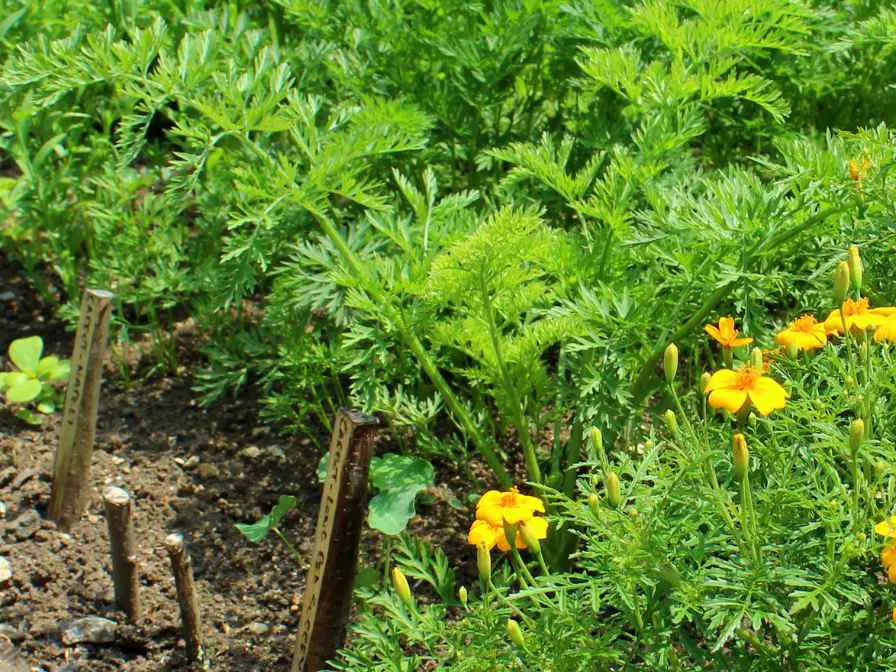Beetroot is a great vegetable. It can be used in many forms in garnishes, salads as well. It is a very common and nutritious plant. when planting beetroot people do think about what to plant along with beetroot. There are many companion plants for beetroot. We are going to tell you about that, you can choose any.

Beetroot
Beetroot, also known as beets or garden beets, is a root vegetable widely grown and consumed worldwide. It is a rich source of vitamins, minerals, and antioxidants, making it a popular choice for health-conscious individuals. Beetroot is typically deep red or purple. Although some varieties can be white or yellow.
Beetroot is a nutritious vegetable that is low in calories and high in fiber, vitamins, and minerals. It is particularly high in folate, which is important for healthy fetal development during pregnancy. It also contains nitrates, which can help to improve athletic performance and lowering blood pressure.
Beetroot is a great source of antioxidants, which can help to protect against disease and slow down the aging process. Beetroot can be consumed raw or cooked and is a versatile ingredient in many different dishes. It can be roasted, boiled, pickled, or blended into smoothies or juices.
Beetroot is also commonly used as a natural food coloring, due to its intense red color. Overall, beetroot is a healthy and tasty vegetable that can be enjoyed in a variety of different ways.
Benefits of Planting Beetroots
Planting beetroot can have numerous benefits, both for individuals and the environment. Here are a few:
Nutritious and healthy food
As mentioned earlier, beetroot is a highly nutritious vegetable that is low in calories and high in vitamins, minerals, and antioxidants. By planting beetroot in your garden, you can ensure a fresh and healthy supply of this nutritious vegetable for your family.
Sustainable and eco-friendly
Growing your vegetables, including beetroot, can help reduce your carbon footprint. By reducing the transportation and packaging needed to bring vegetables to your table. Additionally, planting beetroot can help enrich the soil with nutrients. It supports biodiversity by providing food and habitat for beneficial insects.
Cost-effective
Planting beetroot can also be cost-effective in the long run. By investing in a small garden and some basic gardening tools, you can produce your supply of beetroot for a fraction of the cost of purchasing it at a grocery store.
Gardening as a hobby
Planting beetroot and other vegetables can be a fulfilling and enjoyable hobby. Gardening provides an opportunity to connect with nature, reduce stress, and develop new skills. Plus, there’s nothing quite like the satisfaction of seeing the fruits (or vegetables) of your labor.
Things to Consider Before Planting Beetroot
Here are some things to consider when choosing companion plants for beetroot:
Growing requirements
Choose plants that have similar growing requirements to beetroot, including sun exposure, soil type, and watering needs.
Complementary benefits
Look for plants that offer complementary benefits, such as those that can help to deter pests or improve soil health.
Competing plant
Avoid planting crops that may compete with beetroot for nutrients or space, as this can reduce yield and productivity.
Crop rotation
Consider crop rotation when choosing companion plants, as it’s important to rotate crops each season to prevent soil-borne pests and diseases.
Personal preferences
Consider your personal preferences and what other crops you may want to grow in the same area. For example, if you plan to grow tomatoes, consider planting basil or marigolds alongside beetroot to benefit both crops.
By taking these factors into account, you can choose companion plants that will help to maximize yield and productivity while promoting a healthy and diverse garden ecosystem.
Companion Plants for Beetroot

Companion planting is a gardening technique that involves planting different plants together to achieve certain benefits. The benefits of companion planting include improved soil health, better pest control, increased pollination, and higher crop yields.
This technique can also help to conserve water and reduce the need for synthetic fertilizers and pesticides. Some common examples of companion planting include planting basil with tomatoes to improve their flavor and deter pests, or planting beans with corn to help fix nitrogen in the soil.
While there is no one-size-fits-all approach to companion planting, experimenting with different plant combinations and observing their effects can help you achieve a healthy and productive garden. Overall, companion planting is an effective and sustainable way to grow a variety of crops while promoting biodiversity and ecological health.
Here we are going to discuss some of the companion plants which are quite suitable as a companion plant for beetroots:
Garlic
Garlic is a natural pest repellent and can help deter aphids, spider mites, and other beetroot pests. It also helps to improve soil health and can deter fungal diseases. It can also help eliminate many health issues as it has many medicinal properties.
Onions
Like garlic, onions can help deter pests and improve soil health. They also release sulfur compounds into the soil, which can help to repel harmful nematodes. These are an important part of the kitchen, as used in many shapes and forms.
Carrots
Beetroot and carrots have similar growing requirements, and planting them together can help to maximize space and yield. Carrots also help to loosen soil and can improve beetroot growth.
Lettuce
Lettuce is a great companion plant for beetroot because it has shallow roots and won’t compete with beetroots for nutrients. Lettuce can also help to shade the soil and keep it cool, which can benefit beetroot growth.
Marigolds
Marigolds are a natural pest repellent and can help to deter beetroot pests like nematodes and root maggots. They also help to improve soil health and can attract beneficial insects like bees and butterflies.
Nasturtiums
Nasturtiums are another natural pest repellent that can help to deter beetroot pests like aphids and flea beetles. They also attract beneficial insects and can improve soil health. It has very beautiful flowers which add great ornamental value.
Dill
Dill is a natural pest repellent that can help to deter aphids and spider mites. It also attracts beneficial insects and can help to improve soil health. This herb has a fresh citrus-like taste. It has a lot of medicinal benefits.
Spinach
Spinach is a great companion plant for beetroot because it has shallow roots and won’t compete for nutrients. It also helps to shade the soil and keep it cool, which can benefit beetroot growth. This leafy green vegetable is quite healthy and much preferred.
Radishes
Radishes are a good companion plant for beetroot because they help to loosen soil and can improve beetroot growth. They also mature quickly, which can help to maximize space and yield. There are different types varieties and colors of radishes available.
Sage
Sage is a natural pest repellent that can help to deter beetroot pests like slugs and snails. It also attracts beneficial insects like bees and butterflies and can improve soil health. It is a very nutritious herb. It can be eaten fresh and dried in the tea as well.
In short, beetroots are a great choice for planting. There are a lot of companion plants that can go along the beetroot plants easily. You have to select according to the particular plant’s availability, preference, and care level. you can choose any of these mentioned plants.
FAQs
What is the best companion plant for the beetroot?
Well, we cannot say any one of these. It is because there are many companion plants of the beetroot. You can choose based on the qualities you need. Some of the common ones are lettuces, dill, sage, and others. Well, we can tell bad companion plants of beetroot which are tomatoes and beans.
What is the secret to growing beetroots?
Well, the proper care of the plants is the key for all the plants to be successful. You can get a good beetroot harvest if you provide well-draining soil, good nutrients, and at least sun exposure of 6 hours to the beetroot plants.
How long does beetroot take to grow?
It can take 7 to 12 weeks to get the fully grown beetroots. So you have to choose the companion plants accordingly.

